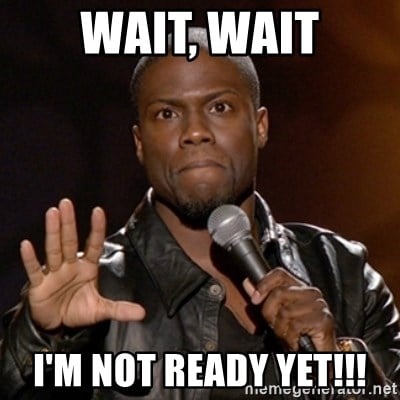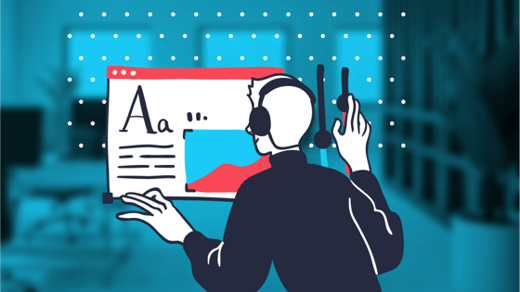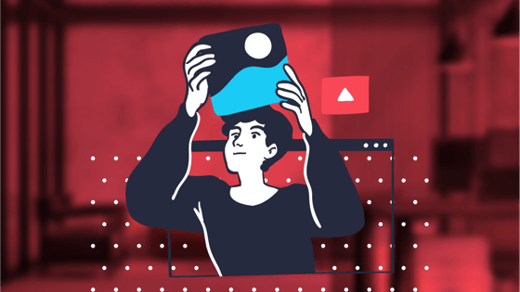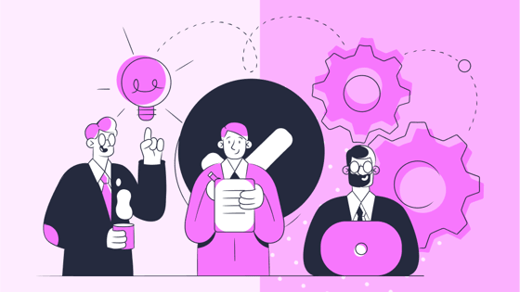Are you losing customers to your competitors?
Do you find that your efforts to turn prospects into customers are not yielding results? The B2B buying process is a tough nut to crack.
You may have the perfect product that completely solves your customers’ needs.
But without an intuitive buyer’s journey, you’ll struggle to catch the attention of your ideal customers and lose out to competitors.
At Lean Labs, we know that friction is the main culprit for poor results and lack of ROI. We’ll help you identify friction points and learn how to eliminate them from the buyer’s journey.
We’ll show you how to maximize your efforts, increase engagement, and convert the right prospects into customers.
This article will provide the insights and tools you need to succeed in the modern B2B buying landscape.
What is the B2B Buyer’s Journey?
Businesses go through the B2B buyer’s journey when making purchases. The process typically has three stages: awareness, consideration, and decision-making. The buyer’s role in the organization, the product or service’s complexity, and the business’s size can all affect the process.
Without a solid understanding of the B2B buyer’s journey, all you can do is throw marketing tactics at the wall and hope something sticks. And you might get lucky! But in the long run, a lack of marketing ROI will frustrate you and the rest of your team.
To further complicate things, every buyer’s journey is unique. One potential customer might find your business online and immediately sign up. Another might take six months to nurture before you even get them on a call.
Prepare for either scenario. Only you can know what the buyer journey is for your product or service. If you already have customers, they are your best source of information for building a replicable buyer journey.
Let’s find out why.
Understanding the B2B Buyer’s Journey
Most marketers agree that the B2B buyer journey has three main stages.
Awareness
In the awareness stage, customers experience symptoms of a problem. They search for information on what they’re experiencing and hopefully come across your website or blog. Because you focus on creating relevant and helpful content, they start perusing what you offer. Awesome!
Of course, that’s the ideal frictionless scenario (more on friction later).
To optimize this stage, there are various strategies you can use, but they all point back toward content. Whether that’s a blog, video, social media, or podcast, you can create content that answers potential buyers’ questions.
Related: [ULTIMATE GUIDE] Lead Generation Through Content Marketing
Now, the content you decide to create must be relevant to your ideal customer. How do you make it relevant? By conducting research. Using customer surveys, ask your current customers what their number one problem was that led them to find your content.
What did they search for? How did they describe their issue? What words did they use?
Pro tip: To further optimize this stage, consider the next step. By that, I mean if a potential customer finds your content and decides to look at your website, your homepage grabs their attention with a headline and a unique value proposition that tells them the result they’ll get from working with you.
Metrics that help track performance in the awareness stage are
- Traffic metrics, including impressions, page views, bounce rates, and top traffic sources.
Consideration
At this point, your potential buyer is aware of their problem, has probably named it, and is now looking for viable solutions. Naturally, you want to be that solution. But how can you tell them you’re the one they’re looking for?
The aim here is to provide value without expecting anything in return. But what you’re doing is sowing the seeds of trust. You can use lead magnets to educate buyers further, automated email sequences to nudge buyers along the journey, or wow them with personalized content.
To optimize this stage, put yourself in your customers’ shoes. They want to weigh their options, look for ways to educate themselves about each solution, and create a shortlist of potential businesses. Can you create content that helps them do that?
For example, let’s say they’re cost-conscious. They’ll want to see a pricing page. Is your pricing transparent? Or does your pricing page lead them on a wild goose chase?
Imagine if, out of five businesses, yours is the most transparent. Would that build trust (yes is the only answer)? Meet your buyer where they are in their journey.
Metrics that help track performance at this stage are
- MQLs (the people who are aware of what you can do for them and are open to learning more about you
- Conversion rates (do your marketing assets compel buyers to take the next step?)
Decision
In the decision stage, your potential buyer is ready to, well, decide if they want to work with you. Why should they work with you? What about you is different from your competitors? You’ve got to convince them.
This is an opportunity to provide product comparisons, testimonials, and case studies. Case studies are relatable. Miss X wants to know that Miss Y uses your product to solve the same problems she’s having. Paint a picture of what will happen when they sign on the dotted line.
To optimize this stage, be ready for objections. What objections have come up before? Look to your current customers. Did anything hold them back before they decided to work with you? Maybe they were worried they couldn’t get their team on board. Or they wouldn’t be able to prove ROI.
How did you put their mind at ease? What language did you use? Objections that come up regularly make great content that you and your sales team can use.
Metrics that help track performance here include
- Customer Acquisition Cost
- Marketing ROI
- Close sales rate
Note: You might think I’ve glossed over the metrics for each section. I wouldn’t do that to you! You can find a deep dive into metrics in our article The 6 Growth Marketing Metrics Every Business Needs to Track (& How to Track).
Identify Friction Points
We promised to help you eliminate friction in this article, so let’s begin.
What is Friction in the Buyer’s Journey?
If your website is underperforming, you can’t generate enough leads, and marketing is unprofitable, there’s only one culprit: friction.
Something is stopping your ideal buyers from biting. They know you’re there. They see you. They visit your website, consume your content, and think about moving forward, but something isn’t quite right.

What are the Common Friction Points?
As always, it depends on your market. But, there are common points across all industries.
Lack of relevant information: When buyers can’t find the information they need to make an informed choice, they will lose interest. Buyers shouldn’t have to search for what they need. You have nothing to hide. Can buyers easily find reviews? Testimonials? Pricing?
Confusing or complex processes: The forms on your website shouldn’t be more detailed than they need to be. Buyers don’t want to fill out a visa application; they just want access to your lead magnet. The same goes for pricing again. Do you have 17 pricing options or force prospects to talk to sales to get pricing information? You’ll only frustrate buyers.
Inadequate customer support:: Buyers fall through the cracks when marketing and sales teams aren’t aligned or there’s friction in your sales pipeline. When customers can’t contact sales representatives quickly to get timely answers to their inquiries, they’ll drop off.
No personalization: Buyers will feel like just another number without personalized communication. And if they receive marketing assets that don’t interest them or answer their questions. Here’s one of many statistics that shows the importance of personalization: 72% of customers will only engage with personalized messaging.
Self-centered: That might feel harsh, but guess what? It’s not about you and your product. How many awards you’ve won, and how fantastic your product is. Your customer doesn’t see themselves in that story. All they’ll say is, “So what?” When you want them to say, “That’s me!”
What are the Common Sources of Friction?
Where can you identify the friction points I outlined above?
On brochure websites, for starters. Does your website scream Me! Me! Me! Is it a 5-page advertisement for your fantastical products? It’s not going to cut it, my friend. Instead, you want your customers to think, “Ah, these guys really get me.”
Poor converting offers suffer from the same problems. If your offers aren’t converting, are you spending time trying to figure out why? Did you ensure your lead magnet is actually valuable to your prospects?
Otherwise, you’ve just spent six months creating a beautiful lead magnet nobody wanted.
Another common source of friction is a lack of differentiation. Why should a buyer choose you over your competitors? What sets you apart if you provide the same service and use similar messaging? Definitely not your brochure website.
Lastly, rushing to market will cause friction. We’re all for launching MVPs (minimum viable products), but if you launch a marketing campaign without
- Knowing who your ideal customer is
- Assessing the needs of the market
- Testing your messaging
You’re setting yourself up for failure. You might even damage your reputation.
Related: Go-To-Market Strategy for Startups: 10 Key Steps (+ Examples)
How to Identify Friction Points in the Buyer’s Journey
Now that you understand some common sources of friction, it’s time to identify the friction in your buyer’s journey. With an inquiring mind, look at your business from a birdseye and a granular view.
-
Conduct market research: Gather insights into buyers’ challenges during the buying process through surveys and focus groups. Talk to your customers. Why did they choose you over another provider? Where did they experience friction in the buying process?
-
Analyze data: Use analytics tools to understand the behavior of visitors on your website and identify any areas of confusion or frustration. Look at page metrics, screen recordings, heat maps, and on-page surveys.
-
Conduct user testing: Ask your users for feedback on any confusion or difficulty they encountered while using your website or marketing campaigns.
-
Review customer feedback: Analyze customer feedback, including reviews, customer service inquiries, and social media comments, to identify common issues. Also, look at review sites like G2 and Yelp to find common complaints and trends.
-
Consider the customer’s perspective: Think about the user experience from the customer’s perspective. Consider factors like website navigation, messaging clarity, and ease of completing actions.
What You Shouldn’t Do To Overcome Friction in the Buyer’s Journey
Don’t ignore friction. Ignoring it is the default response from many businesses. It can be challenging to accept that something you’ve spent time and resources on isn’t working. But you must be able to pivot and take a new approach when things don’t go well.
It’s also not a great idea to throw more money at it. You can’t build a better website without first identifying what’s going wrong. The same applies to marketing campaigns. You need a clear strategy that targets the root cause of the friction.
Lastly, don’t work with agencies that charge for outputs instead of outcomes. It’s common for some agencies to do the work and ignore the results. They still get paid, and you get left with a campaign that produces no return on investment.
How to Eliminate Friction in the Buyer’s Journey
Finally, the pièce de résistance. Here are eight actionable tips you can steal to overcome friction in the buyer’s journey.
1. Build a High-Conversion Website
Your website is your best salesperson, especially in the B2B space. When customers search for solutions to their problems and come across your content, they will likely enter your website. What will greet them? Hopefully…
- Clear and intuitive navigation that guides them through your website
- A UVP (Unique Value Proposition), prominently placed, that clearly highlights the result your buyer will get if they work with you, how you help them achieve that result, and how you do it differently.
- Compelling calls to action (CTAs) that drive conversions. Place them strategically throughout the website and encourage buyers to take action.
- Optimized website speed–slow speeds lead to frustration and high bounce rates.
- A visually appealing design that captures attention. It should be clean, modern, and easy to navigate.
Related: Is Your SaaS Website Design Optimized to Fuel Growth?
2. Personalizing the Journey
The statistics speak for themselves:
- 90% of marketers rely on personalization to drive profitability
- According to HubSpot, personalized CTAs outperform default versions by 202%.
- 90% of customers spend more with companies that personalize customer services.
When you personalize the B2B journey, you start building a relationship. How to put personalization into practice?
- Create a buyer persona that serves as a detailed profile of your ideal client. Personalization starts before any contact with your customer. When you develop messaging that makes your ideal client put their hand up and say, “That’s me!” you’re already starting to build a personal relationship.
- Segment your audience Break your target market into smaller groups to create more targeted and relevant messaging. You can also use smart or dynamic content. For example, let’s say you create a landing page for a new product launch. Using smart content, you can show users a different version of your page based on their location, language, or other demographic information.
- Personalize communication. Following buyer personas and segmentation, you can use smart content and automation to send tailored messages and content to buyers depending on their journey. Use data and insights about each buyer to create more personalized and engaging experiences. The same goes for content. Think about every stage of the journey and consider sending whitepapers, webinars, and case studies that speak directly to pain points and interests.
3. Streamline the Sales Process
With enough sticking points already, how can you streamline the sales journey? Do all you can to make the sales process smooth, efficient, and transparent. Strategies here include qualifying leads, aligning marketing and sales, establishing sales pipeline stages, and using data to track metrics.
- Qualifying leads: Focus on your most promising leads. Use lead scoring to identify leads based on their level of interest, budget, and fit with your product. Focusing on the most promising leads will improve conversion rates and stop wasting time on leads that won’t buy.
- Align marketing and sales: Notoriously hard to do, when you align sales and marketing teams and create a shared understanding of the buyer journey, you’ll create more targeted and relevant messaging, content, and offers that speak directly to the needs and interests of each buyer.
- Establish sales pipeline stages: Break down the sales process into clear, well-defined steps corresponding to specific actions and outcomes. Salespeople often manage multiple prospects and deals, so having a visual representation of the sales process will help to plug gaps and avoid prospects dropping off.
- Use data to track metrics: Gather and analyze data on key sales metrics, such as conversion rates, deal velocity, and win/loss ratios. By tracking these metrics, sales teams can identify areas of the sales process that may need improvement and make data-driven decisions about allocating resources and prioritizing efforts.
4. Content is King
Today’s B2B buyer does a lot of their own research. But they still want to learn. Sharing knowledge that helps you align with your customers is essential. Effective content is simple, helpful, and relevant to your buyer persona. It’s important to create content for each stage of the buyer’s journey.
Related: SaaS Content Writing: How to Attract, Engage, and Delight Your Customers
As they move through the awareness, consideration, and decision stages, help them solve problems, show them how your product facilitates successfully solving those problems, and build trust and credibility.
You can provide valuable insights, tips, and advice through videos, blog posts, thought leadership, webinars, and more.
Use lead magnets to educate prospects and build trust. Your lead magnet should quickly solve an issue or problem, leading to a quick win and immediate trust. Think of a lead magnet as an appetizer. Make them hungry for more.
5. Build Trust Throughout the Buyer’s Journey
I’ve mentioned trust and authority a few times in this article. People buy from people they trust. You want customers to engage with you, share their information, and buy from you. A lack of trust and authority will lead to skepticism, hesitation, and lost sales.
Be open and honest with buyers. Provide clear information about product features, pricing, and delivery times, and don’t be afraid to say who your product isn’t for. Deliver on your promises and follow through on commitments. If you say you provide stellar customer service, you better back it up.
Something that riles me up is the lack of transparency during free trials. Why would I trust you if you don’t make it obvious that you’ll charge my card after seven days? Blinkist does this well:
Maintain privacy! You’ll have sensitive customer information, such as payment details and contact information, and being transparent about how customer data is collected, stored, and used is crucial.
Lastly, provide some kind of guarantee. For example, at Lean Labs, we promise value over profit. If we don’t deliver on what we promise, we’ll keep working (for free) until we do.
6. Addressing Objections
Objections and friction go hand-in-hand.
Think of objections more as concerns or reservations. Don’t those words feel less aggressive and easier to manage? When sales and marketing teams align, sales teams can pass marketers the most common concerns buyers have, and marketers can create content to address those concerns.
When you dig deep into what customers want and need throughout the buyer journey, you can provide relevant and helpful information to stop objections from coming up in the first place. Listen in on sales calls.
Find common concerns and create a blog post that answers those concerns.
You don’t have to guess about any of this. Ask your current customers for any friction points they encountered during the buyer journey. Ask them how you could have improved or made the buying process easier.
7. Foster Relationships
With such a long buying process, losing track of deals and letting relationships slide is easy. Focusing on the best leads is essential, but some leads aren’t ready to pull the trigger. It doesn’t mean they won’t ever be.
With a well-thought-out sales process, you can ensure you follow up on all leads promptly and effectively. Use your lead nurturing programs to engage buyers and automation to trigger conversations. You can automate newsletters, social media updates, and anything that helps keep you front of mind.
Another play is to ask for customer feedback. For example, when customers are in the middle of a free trial, get their input on what you can do better and how to improve the overall experience. Use surveys, focus groups, and other forms of market research. Make it easy to provide feedback.
8. Make Data-Driven Decisions
I once said, “The road to success is paved with data.” Witty, huh? But also true.
We have so much data at our fingertips. And yet 87% of marketers consider data their organization’s most underutilized asset. What a waste! Instead, use data to provide personalized and relevant service to your customers.
“But where will I store it all and how do I utilize it?”
Enter a customer relationship management (CRM) platform. HubSpot is pretty good (we use it with all our clients). We can look at the following:
- Browsing patterns
- The amount of time users spend on a page
- CTA conversion rates
- Customer lifetime value
- Traffic numbers and sources
- Sales reports to analyze buyer behavior
- Trends and patterns
- Average deal sizes
And so much more.
How can you put it into practice, so you’re not just collecting data?
A simple example is A/B testing. If your CTA isn’t converting, create another version with different messaging and see which performs better. There are various tests you can perform so you can rely on data to make better business decisions.
The B2B Buyer’s Journey: Maximize the Customer Experience
Your customers are your best marketers. They’re also the best people to tell you how to optimize the B2B buyer journey. You’ll need to discern whether they’re right, but the majority of the time, how they feel about the buyer journey is crucial to successfully optimizing it.
Find out why they chose you, what they loved about the buyer journey, and how easy you made their decision.
You can eliminate friction in your sales process by attracting the right leads and fostering long-term relationships that make it easy for potential customers to buy.
Are you stuck? Is there friction in your buyer journey?
Get unstuck today. Our clients use the Growth Grader tool to grade their current marketing performance and establish an accurate baseline. You’ve got nothing to lose. You’ll either identify where the friction is or pat yourself on the back for a job well done.
Either way, start eliminating friction in the buyer journey today.
Tags:
Growth MarketingMay 10, 2023





Comments